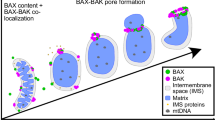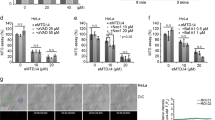Abstract
Mitochondria play a key role in apoptosis due to their capacity to release potentially lethal proteins. One of these latent death factors is cytochrome c, which can stimulate the proteolytic activation of caspase zymogens. Another important protein is apoptosis-inducing factor (AIF), a flavoprotein that can stimulate a caspase-independent cell-death pathway required for early embryonic morphogenesis. Here, we report the crystal structure of mouse AIF at 2.0 Å. Its active site structure and redox properties suggest that AIF functions as an electron transferase with a mechanism similar to that of the bacterial ferredoxin reductases, its closest evolutionary homologs. However, AIF structurally differs from these proteins in some essential features, including a long insertion in a C-terminal β-hairpin loop, which may be related to its apoptogenic functions.
This is a preview of subscription content, access via your institution
Access options
Subscribe to this journal
Receive 12 print issues and online access
$189.00 per year
only $15.75 per issue
Buy this article
- Purchase on Springer Link
- Instant access to full article PDF
Prices may be subject to local taxes which are calculated during checkout



Similar content being viewed by others
Accession codes
References
Lorenzo, H.K., Susin, S.A., Penninger, J. & Kroemer, G. Cell Death Differ. 6, 516–524 (1999).
Joza, N. et al. Nature 410, 549–554 (2001).
Arnoult, D. et al. Mol. Biol. Cell 12, 3016–3030 (2001).
Miramar, M.D. et al. J. Biol. Chem. 276, 16391–16398 (2001).
Massey, V. J. Biol. Chem. 269, 22459–22462 (1994).
Bernardi, P., Petronilli, V., Di Lisa, F. & Forte, M. Trends Biochem. Sci. 26, 112–117 (2001).
Green, D.R. & Reed, J.C. Science 281, 1309–1312 (1998).
Susin, S.A. et al. Nature 397, 441–446 (1999).
Dumont, C. et al. Blood 96, 1030–1038 (2000).
Zhou, G. & Roizman, B. J. Virol. 74, 9048–9053 (2000).
Senda, T. et al. J. Mol. Biol. 304, 397–410 (2000).
Rogers, S., Wells, R. & Rechsteiner, M. Science 234, 364–368 (2000)
Ernst, M.K., Dun, L.L. & Rice, N.R. Mol. Cell. Biol. 15, 872–882 (1995)
Adzhubei, A.A. & Sternberg, M.J.E. J. Mol. Biol. 229, 472–493 (1993)
Kay, B.K., Williamson, M.P. & Sudol, M. FASEB J. 14, 231–241 (2000)
Ravagnan, L. et al. Nature Cell Biol. 3, 839–843 (2001).
Ghisla, S. & Massey, V. Eur. J. Biochem. 181, 1–17 (1989).
Pai, E.F. & Schulz, G.E. J. Biol. Chem. 258, 1752–1757 (1983).
Flocco, M.M. & Mowbray, S.L. J. Mol. Biol. 254, 96–105 (1995).
Reshetnyak, Y.K. & Burstein, E.A. Biophys. J. 81, 1710–1734 (2001).
Fraaije, M.W. & Mattevi, A. Trends Biochem. Sci. 25, 126–132 (2000).
Susin, S.A. et al. J. Exp. Med. 192, 571–580 (2000).
Iwata, S. et al. Science 281, 64–71 (1998)
Colbert, C.L., Couture, M.M.-J., Eltis, L.D. & Bolin, J.T. Structure 8, 1267–1278 (2000).
Leslie, A.G.W. Joint CCP4 and ESF-EACBM Newsletter on Protein Crystallography. 26 (1992).
Collaborative Computational Project, Number 4. Acta Crystallogr. D 50, 760–763 (1994).
Sheldrick, G.M. Methods Enzymol. 276, 628–641 (1997).
Navaza, J. Acta Crystallogr. D 50, 157–163 (1994).
McRee, D.E. J. Mol. Graph. Model. 10, 44–46 (1992).
Sharp, K.A. & Honig, B. Annu. Rev. Biophys. Biophys. Chem. 19, 301–332 (1990).
Kraulis, P.J. J. Appl. Crystallogr. 24, 946–950 (1991).
Merritt, E.A. & Bacon, D.J. Methods Enzymol. 277, 505–524 (1997).
Acknowledgements
We acknowledge A. González and A. Munro for helpful discussions, R. Nageotte for technical help with analytical ultracentrifugation, the European Synchrotron Radiation Facility for access to their installations and the Institut Pasteur, as well as ARC, for financial support to P.M.A. M.J.M. and M.O.L. were recipients of EMBO/ARC and FEBS postdoctoral fellowships, respectively.
Author information
Authors and Affiliations
Corresponding author
Ethics declarations
Competing interests
The authors declare no competing financial interests.
Rights and permissions
About this article
Cite this article
Maté, M., Ortiz-Lombardía, M., Boitel, B. et al. The crystal structure of the mouse apoptosis-inducing factor AIF. Nat Struct Mol Biol 9, 442–446 (2002). https://doi.org/10.1038/nsb793
Received:
Accepted:
Published:
Issue Date:
DOI: https://doi.org/10.1038/nsb793
This article is cited by
-
Structural insights into FSP1 catalysis and ferroptosis inhibition
Nature Communications (2023)
-
AIF Overexpression Aggravates Oxidative Stress in Neonatal Male Mice After Hypoxia–Ischemia Injury
Molecular Neurobiology (2022)
-
The key players of parthanatos: opportunities for targeting multiple levels in the therapy of parthanatos-based pathogenesis
Cellular and Molecular Life Sciences (2022)
-
AIF3 splicing switch triggers neurodegeneration
Molecular Neurodegeneration (2021)
-
The human papillomavirus E6 protein targets apoptosis-inducing factor (AIF) for degradation
Scientific Reports (2020)



